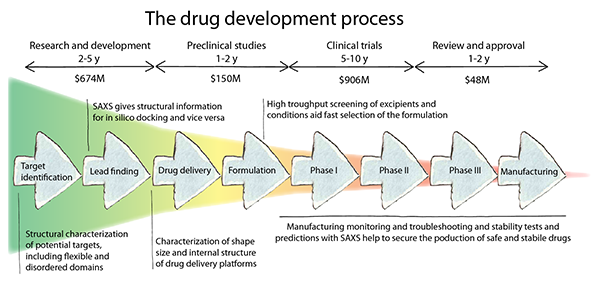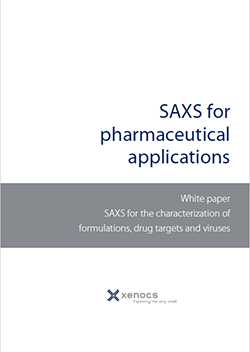The global COVID-19 pandemic stresses the necessity to accelerate the different stages of drug development, reduce drug candidate attrition rates and establish solid testing protocols to ensure that only safe and stable formulations enter the market. Small Angle X-ray Scattering (SAXS) can help tackle several of these challenges by offering a fast and robust protocol to analyze the structure, morphology and interactions in the involved systems.
This white paper demonstrates how SAXS and WAXS (Wide-Angle X-ray Scattering) facilitate research, development and quality control at the various stages of drug and vaccine development. Using examples from the peer-reviewed scientific literature as well as interviews with academic and industrial partners, we describe how high-throughput screening accelerates preclinical development and how SAXS can function as a fingerprint technique for troubleshooting, manufacturing monitoring and quality control. Next, we consider the role SAXS can play for drug and vaccine target discovery, followed by the SAXS analysis of viruses. The figure summarizes the treated topics on the drug development timeline.

Why SAXS?
The technique resembles light scattering, however, the shorter wavelength of X-rays extends the probe length scale to the molecular level while at the same time it is less prone to artefacts and gives access to a multitude of parameters. While much of the pioneering research relied on large facilities where synchrotron radiation is used as the X-ray source, laboratory SAXS is now common due to the advances made in the last decade. It is an established component of the structural biology toolbox used for the shape and size characterization of proteins (including antibodies and antigens), characterization of protein complexes, as well as DNA and RNA. Its application in other pharmaceutical areas, like formulation, is recently gaining interest.
The key benefits of SAXS and WAXS are:
- Suitable for all types of samples (i.e. liquid, solid, paste…)
- No tedious sample preparation required
- Near–native state measurements in solution
- Can be done in a wide concentration range
- Static and dynamic sample manipulation possible (i.e. temperature, shear, humidity…)
- Low sample volumes of down to 5 μl
- Measurements can be done in-house
- Statistically relevant results can be obtained with one measurement
- Measurements can be automated and performed with high-throughput
- Appropriate for R&D as well as quality control and troubleshooting
- Supplements high resolution structural determination tools (e.g. NMR, Cryo-EM, etc)
- Good framework for combination with in silico modelling

In brief, SAXS and WAXS are performed in a near-native sample environment, hence circumventing tedious sample preparation while giving access to the solution structure. This gives unique insights into structural information about intrinsically disordered and flexible domains in proteins and genetic material. Readily accessible SAXS/WAXS laboratory instruments that are devoted exclusively to the needs of structural biology for drug development, are commercially available. These include automated and high-throughput solutions with low sample consumption. The unique and rapid characterization from X-ray scattering contributes to shorter time-to-market and a better understanding of structural properties for new drugs and vaccines.
































